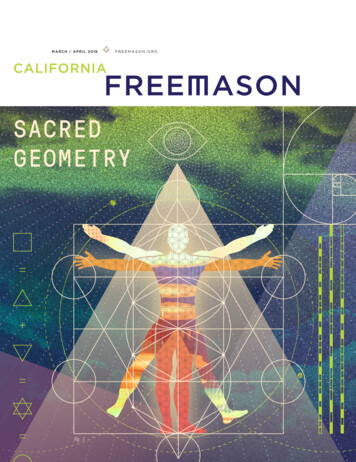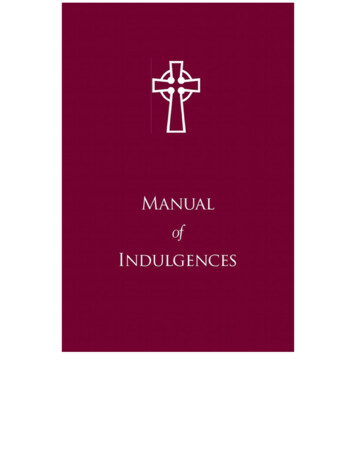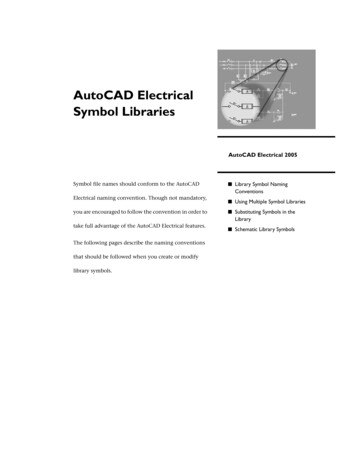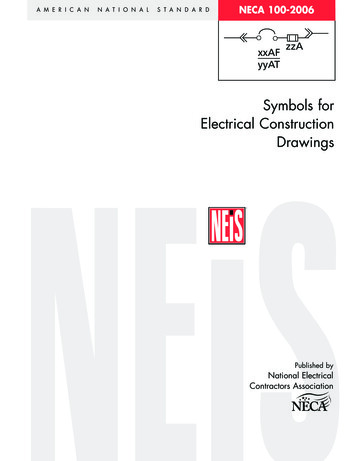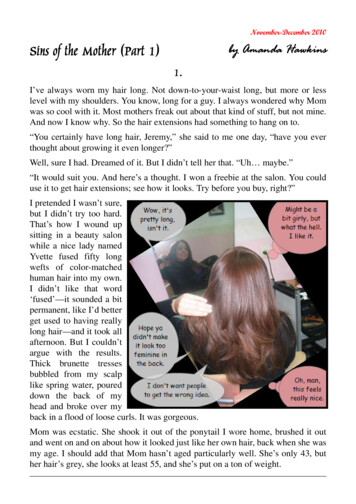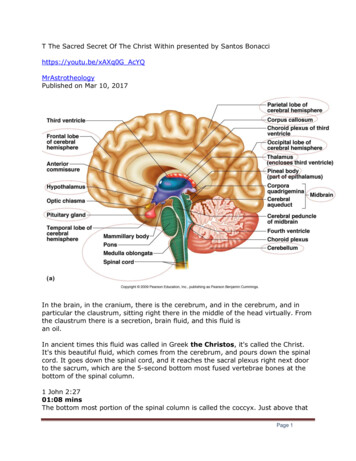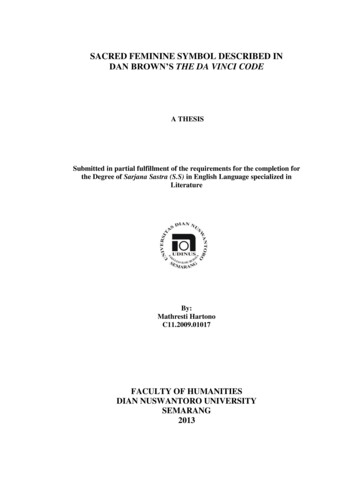
Transcription
SACRED FEMININE SYMBOL DESCRIBED INDAN BROWN’S THE DA VINCI CODEA THESISSubmitted in partial fulfillment of the requirements for the completion forthe Degree of Sarjana Sastra (S.S) in English Language specialized inLiteratureBy:Mathresti HartonoC11.2009.01017FACULTY OF HUMANITIESDIAN NUSWANTORO UNIVERSITYSEMARANG2013
STATEMENT OF ORIGINALITYI certify that this thesis is absolutely my own work. I am completely responsiblefor the content of this thesis. Opinions or findings of others are quoted and citedwith respect to ethical standard.Semarang, August 2013Mathresti Hartono
MOTTOGood does never mean good and bad does never mean bad. Dare to choose andnever look back. Everything can change depends on how you look and handle it,because every things in this world has many sides to be seen.
DEDICATIONThis thesis is dedicated to:-My parents-My family-My University, Dian Nuswantoro University
ACKNOWLEDGEMENTAt this happiest moment, I would like to wish a prayer to my Lord, JesusChrist who has blessed me during writing this thesis.Furthermore, I would like to express my sincere thanks to:1. Mr. Achmad Basari, S.S., Dean of Faculty of Humanities of DianNuswantoro University, who gave me permission to conduct this thesis.2. Mr. Sunardi, S.S., M.Pd., The head of English Department of Strata 1Program, Faculty of Humanities, Dian Nuswantoro University, who gave mepermission to conduct this thesis.3. Ms. Valentina Widya, S.S., M.Hum., my adviser, for her continuous anvaluable guidance, advice, and encouragement in completing and finishingthis thesis.4. Mrs. Haryati Sulistyorini, M.Hum., who has help me by giving me referencesabout semiotic research and how to do semiotic research.5. Mr. Muhammad Rifqi, S.S, M.Pd., who has help me by giving me anotherbook of theories of semiotic.6. All lectures at the English Department of Faculty of Humanities of DianNuswantoro Unversity, who have taught, motivated, given guidance and achance to get more experience and develop my skill in English languageduring studying in English Department of Faculty of Humanities of DianNuswantoro University.
7. The librarians of Self Access Centre of Faculty of Humanities of DianNuswantoro University for her permission to me for using some valuablereferences to write this thesis.8. My parents for their support by asking me when I finish my thesis and have agraduation and their unlimited prayer for my success in writing this thesis.9. My boyfriend, “AK”, thanks for your support that I can do this thesis wellwhen I thought I cannot do it.10. All my friends in English Department of Faculty of Humanities of DianNuswantoro University, especially Ima and Ajeng who have given mesupport during writing this thesis.Finally, I do realize that due to my limited ability, this thesis must haveshortcoming. For this I welcome any suggestions and critics.Semarang, August 2013The WriterMathresti Hartono
ABSTRACTThe Da Vinci Code is a novel telling about a journey of a woman, named SophieNeveu who tries to reveal a message of her grandfather through a series of riddlesthat he made before he died. This journey involving some symbols of sacredfeminine those become her grandfather interest. Because of those sacred femininesymbols, the writer is interested in analyzing the sacred feminine symbols foundin The Da Vinci Code novel. There are some objectives that the writer wants todeliver in this thesis. First is to describe the sacred feminine symbols in The DaVinci Code and to describe the meaning behind the symbol. The second is todescribe the contribution of sacred feminine symbols in conflict and setting.The library research method was used to gain some information that was neededby the writer to conduct this thesis. Structural approach was applied to analyzecharacter and characterization, conflict, and setting. Semiotic approach wasapplied to analyze sacred feminine symbol in The Da Vinci Code.The result of the study showed that Sophie Neveu, as a character of The Da VinciCode novel, belongs to round character. She is an orphan and described asbeautiful, wise, responsible, smart, firm, emotional, and risk taking middle agedwoman. There are several sacred feminine symbols found during her journeyincluding herself because her name is rooted from one of goddess’ name. Sheexperiences external conflict with Jacques Sauniere, Robert Langdon and SirLeigh Teabing and internal conflict against herself. Sacred feminine symbols thatshe found and learned in every riddle help her to reveal what her grandfatherwants to tell her and unpredictably lead her to find her grandfather’s murderer.Those symbols also help her to fix her relationship with her grandfather.Keywords: character, conflict, riddle, sacred feminine symbols, semioticapproach
TABLE OF CONTENTSPAGE OF TITLE.iPAGE OF APPROVAL.iiSTATEMENT OF .viABSTRACT.viiiTABLE OF CONTENTS.ixCHAPTER I INTRODUCTION1.1. Background of the Study.11.2. Statement of the Problem.31.3. Scope of the Study.41.4. Objective of the Study.41.5. Significance of the Study.41.6. Method of the Study.51.6.1. Research Design.51.6.2. Unit of Analysis.51.6.3. Source of Data.51.6.4. Technique of Data Collection.51.6.5. Technique of Data Analysis.61.6.5.1. Structural Approach.6
1.6.5.2. Semiotic Approach.61.7 Thesis Organization .7CHAPTER II AUTHOR AND SYNOPSIS2.1. Dan Brown and His Work .92.2. Synopsis of The Da Vinci Code .11CHAPTER III REVIEW OF RELATED LITERATURE3.1. Character.133.2. Conflict .153.3. Setting .173.4. Semiotic .203.4.1. Symbol .213.4.2. Sacred Feminine Symbol .23CHAPTER IV DISCUSSION4.1. General Description and Characterization ofSophie Neveu .254.2. Conflict .404.2.1. Internal Conflict .414.2.2 External Conflict.464.2.2.1. Sophie Neveu against Jacques Sauniere .464.2.2.2. Sophie Neveu against Robert Langdon .474.2.2.3. Sophie Neveu against Sir Leigh Teabing .534.3. Setting .564.3.1. Setting of Place .57
4.3.2. Setting of Time .604.3.3. Setting of Social.614.4. Symbol4.4.1. Sophie Neveu.674.4.2. Holy Grail.684.4.3. Rosa Rugosa.704.4.4. The Mona Lisa.724.4.5. Hermaphrodite.734.4.6. Pentacle.734.4.7. The Vitruvian Man.764.4.8. The Star of David.774.4.9. Left.774.5. Contribution of Sacred Feminine Symbols to SophieNeveu’s Conflict and Setting.79CHAPTER V CONCLUSION5.1. Conclusion.865.2. Suggestion.88BIBLIOGRAPHY.89
CHAPTER IINTRODUCTION1.1. Background of the StudySymbol always presents in our daily life. We can find it in any form, suchas movement, sound, statement, color or even thing. One example of symbol isliterary work. Literary work is a picture of human life in written form. As asymbol, literary work has a function as a mirror of real world. It means literarywork represents any activities and phenomena that happened in real world.Human in real world is represented by the character in literary work. Both humanand character, they face conflicts.One type of literary work is novel. Novel is a narrative, tells a story toreaders. It contains elements which build and make the story interesting; they areintrinsic and extrinsic elements. Character, conflict, and setting are intrinsicelements, without them the story will never exist, while one of extrinsic elementsof the story is symbol.Symbol is used to represent something else. The meaning of symboldepends on its place; it means there is different meaning of one symbol if webring the same symbol into different place. It is grown by the society and adoptedthrough generations. Symbol in literary work also has its own meaning. It meansthat we can only find its meaning through the story of the novel. The meaning isbuilt inside the story. That is why literary work has an authority to create itsmeaning.
Dan Brown’s The Da Vinci Code is a novel that tells us a journey ofSophie Neveu and Robert Langdon who try to reveal what Jacques Sauniere wantsto tell. Their journey begins when Jacques Sauniere is found died in GrandGallery, house of painting of famous Italian artists in Louvre Museum. Hearranges his body in Vitruvian Man position with four lines message beside hiscorpse body and a pentacle in his stomach. This strange situation makes SophieNeveu, granddaughter of Jacques Sauniere, and Robert Langdon, a professor ofreligious symbology, are met. They involves in a journey made by JacquesSauniere which full of riddle, and word games. They do not know why JacquesSauniere is involving them in his game and what Jacques Sauniere wants to tell.Sophie Neveu is sure if her grandfather’s game will reveal the truth of her familythat she believes has died in car accident when she was a child. Her journey inrevealing the message of her grandfather, unpredictably help her to understand hergrandfather better than before. She finds the explanation of sex rites that she sawsome years ago which has successfully made her relation with her grandfather hasfallen for a long time. Langdon explains the right definition of the sex rites to her,and for the first time she tells the reason what makes her and her grandfathernever meet and communicate for a long time. She tries to fix her mistake ofabandoning her grandfather and not letting him to explain by attempting to keepthe cryptex that her grandfather gave her and reveal what actually her grandfatherwants to tell her about her family. Her journey with Robert Langdon also helpsher know and learn new things and symbols that she never heard and knew before.She learns if her grandfather is one of the top members of Priory of Sion. Priory
of Sion is the guardian of Holy Grail which she believes is The Cup that used byJesus to share wine in Last Supper and to catch the blood of Jesus in crucifixion.But through this journey, she learns that Holy Grail is not as simple as a cup at all.She learns so much about Holy Grail and the sacred feminine. She learns theconnection between them. The Rose, that she knows is the symbol of secrecy,actually is more than that. It is the symbol of Holy Grail that speaks in manylevels. It relates to Holy Grail through some reasons and its characteristic. Notonly that she also get the right meaning of pagan and pentacle that always relate todevil worship.Based on the previous explanation, the writer decides to analyze symbolsof sacred feminine described in Dan Brown’s The Da Vinci Code. Finally, thewriter chooses “Sacred Feminine Symbol Described in Dan Brown’s The DaVinci Code” as the titles of this thesis.1.2. Statement of the ProblemConnected with the background of the study, the statement of the problem asfollows:1. What are the general descriptions of Sophie Neveu in Brown’s The DaVinci Code?2. What are conflicts experienced by Sophie Neveu in Brown’s The Da VinciCode?3. What are settings described in Brown’s The Da Vinci Code?4. What are sacred feminine symbols described in Brown’s The Da VinciCode?
1.3. Scope of the StudyIn analyzing Brown’s The Da Vinci Code, the writer focuses to analyze onthe general descriptions of Sophie Neveu as character, conflict experienced bySophie Neveu and settings described in Brown’s The Da Vinci Code. The writeralso focuses on the study of semiotic approach especially sacred femininesymbols.1.4. Objective of the Study1. To describe the general descriptions of Sophie Neveu in Brown’s The DaVinci Code.2. To describe conflicts experienced by Sophie Neveu in Brown’s The DaVinci Code.3. To describe settings in Brown’s The Da Vinci Code.4. To describe sacred feminine symbols in Brown’s The Da Vinci Code.1.5. Significance of the StudyThe significance of the study as follows:1. For the writerThe writer wants to find out how structural element, such as character,conflict, setting and semiotic approach especially symbol can build thestory in Brown’s The Da Vinci Code.2. For the readerTo give more knowledge about the structural elements in literature likecharacter, conflict, and setting, beside to improve the reader’s knowledgein symbol as semiotic approach.
3. For the universityTo give a contribution for the library of Dian Nuswantoro University asthe additional references, especially in Faculty of Humanity.1.6. Method of the Study1.6.1 Research DesignThe writer analyzes the data which is in sentence forms. The data,which is found, are analyzed and the result is description. It presentssentences which give clear and detail information related to the data. Becausethe result is description, not a diagram or graphic, it belongs to qualitative.Based on the explanation before, this method is categorized into qualitativedescriptive method.1.6.2. Unit of AnalysisThe writer focuses on sentences which are related to topic of thisresearch that is character, conflict, and setting as structural element and alsosymbol as semiotic approach.1.6.3. Source of DataIn this thesis, the writer chooses Brown’s The Da Vinci Code as theobject of analysis and source of data. For the theories, the writer will usesome books which are relevant and related to the problem discussed.1.6.4. Technique of Data CollectionIn getting data for this research, the writer takes the data from librarycalled library research. All of the data is taken from the book or document.
The writer uses novel, Dan Brown’s The Da Vinci Code, as her primary dataand other references related to the topic to strengthen her research.In making the research, the writer does some steps. First, the writerreads the novel for several times to get deep understanding about the idea ofthe novel. As the result, the writer will get interesting topic to discuss andanalyze for this research.Second, the writer looks for the data related to the topic. Thenanalyze, describe, and connect it to suitable theories related with the topic.1.6.5. Technique of Data Analysis1.6.5.1. Structural ApproachFor the thesis, the writer uses structural approach and semioticapproach. According to Harsono (1999:47-78), “Structural approach refersto the modern linguistic approach which is introduced by Ferdinand deSaussure. This approach based on assumption that literary work as a workof imagination can stand by itself.” The writer uses structural approach toanalyze the intrinsic element of the literary work.1.6.5.2.Semiotic ApproachSemiotic approach is based on the assumption that the literarywork has its potential communicative which is signed by a symbol whichis artistic and dynamic. According to Eco in Nöth (1999: 326) “Semiotic isdefined as a research program which studies all cultural processes asprocesses of communication.” Next he asserts his following definition ofsemiotic in Noth (1990: 326):
Semiotics is concerned with everything that can betaken as a sign. A sign is everything which can betaken as significantly substituting for somethingelse. This something else does not necessarily haveto exist or actually be somewhere at the moment inwhich a sign stands for it. Thus semiotics is inprinciple the discipline studying everything whichcan be used in order to lie.The writer uses semiotic approach to analyze the symbol in literary work.1.7. Thesis OrganizationThis thesis consists of five chapters. They are arranged as follows:Chapter I is Introduction. In this chapter the writer presents background ofthe study, statement of the problem, scope of the study, objective of the study,significance of the study, method of the study which are consists of researchdesign, unit of analysis, technique of data collection and technique of dataanalysis, and thesis organization.Chapter II is Author and Synopsis. In this chapter the writer gives the shortbiography of Dan Brown and his work and the synopsis of Dan Brown “The DaVinci Code”Chapter III is Review of Related Literature. This chapter presents thetheory of structural approach and semiotic approach that is used to analyze thisthesis. The structural approach consists of character and characterization, conflictand setting. While in semiotic approach, the writer focuses on symbol.Chapter IV is Discussion. In Discussion, the writer answers the question ofObjective of the Study. She describes every finding that she found in the noveland strengthens it by giving argument from the novel and literary review.
Chapter V is Conclusion. It presents the conclusion from the previouschapter and suggestion to next researcher about the approach that can be used forthe next research
CHAPTER IIAUTHOR AND SYNOPSIS2.1. Dan Brown and His WorkIn this sub chapter, the writer presents short biography of the writer of TheDa Vinci Code novel that is Dan Brown. The writer takes the short biographyfrom http://en.wikipedia.org/wiki/DanBrown.Dan Brown was born and raised in Exeter, New Hampshire, U.S.A. onJune 22, 1964. He was the eldest of three children. He grew up on the Campus ofPhilips Exeter Academy. Both of his parents are singers and musicians, havingserved as church choir master, with his mother serving as church organist. He wasraised an Episcopalian.His interest in secrets and puzzles was started when he was still a child.The young Brown spent hours working out anagrams, crosswords, and puzzles.On holidays and birthdays, he and his siblings participated in treasure huntdevised by their father to get their gifts.After graduating Philips Exeter Academy, he attended Amherst College.He was a member of Psi Upsilon fraternity. Brown spent the 1985 school yearabroad in Seville, Spain where he was enrolled in an art history course at theUniversity of Seville. He graduated from Amherst in 1986.After graduating from Amherst, Brown dabbled with a musical career,creating effects with a synthesizer, and self-producing a children cassette entitledSynthAnimals, then formed his own record company called Dalliance. In 1993, he
moved to Hollywood to pursue his career as singer-songwriter and pianist and tosupport himself, he taught classes at Beverly Hills Preparatory School.He met with his wife, Blythe, in The National Academy of Songwriters.She was 12 years his senior, and the Academy’s Director of Artist Development.She took on the seemingly unusual task of helping to promote Brown’s project.They developed personal relationship and married in 1997, at Pea Porridge, nearConway, New Hampshire.His first book was Digital Fortress which was inspired from SidneySheldon’s The Doomsday Conspiracy and was published in 1998. Brown’s nextnovel was Angels and Demons and Deception Point, released in 2000 and 2001respectively, the former of which was the first to feature the lead character,Harvard symbology expert Robert Langdon. His fourth novel, The Da Vinci Code,became a bestseller going to the top of the New York Times Best Seller list duringits first week of release in 2003 and now credited with being one of the mostpopular books of all time. Its success has helped push sales of Brown’s earlierbooks. Brown’s third novel featuring Robert Langdon, The Lost Symbol, wasreleased on September 15, 2009. The Lost Symbol also had a big success. Thebook’s selling reached to the five million first printing. Brown has stated that hehas ideas for about 12 future books featuring Robert Langdon. Characters inBrown’s book are often named after real people in his life, for example RobertLangdon is named after John Langdon, the artist who created the ambigrams usedfor the Angels and Demons CD and novel.
2.2. Synopsis of The Da Vinci CodeSophie Neveu is a middle aged woman who works in DCPJ, the JudicialPolice of France, as a code breaker. She is grown up by her grandfather becauseher parent has died in car accident when she was a child. Her grandfather, JacquesSauniere, is the curator of Louvre Museum. It is the most well known museum inworld. She is grown up within her grandfather’s interests. She learns unusualthings for a child. She learns about word games, puzzles and the sort of thing. Hergrandfather likes to make a treasure hunt for her birthday or in Christmas. Histreasure hunts are completed by riddles that she should solve. Jacques Saunierealso introduces her about art, especially the work of Da Vinci, one of famousItalian artists, and her favorite work is The Vitruvian Man. But her relation withJacques Sauniere is fallen. One day in spring, she saw sex rites done by hisgrandfather. Driven by her disappointment, she decides to pack her belongingsand go to London. Keep her distance from her grandfather and not allowing hergrandfather to reach her.After ten years keeps her distance from her grandfather, she gets amessage that her grandfather died. Beside her grandfather corpse, there are fourlines message. She is sure that it aims to catch her attention and it works. Butunpredictably, the message meets her with Robert Langdon, a professor ofreligious symbology. Both Neveu and Langdon do not know why JacquesSauniere meets them and their journey to reveal Jacques Sauniere intention isbegun.
Their journey is complete with riddles made by Jacques Sauniere. Everyriddles contains of work of Da Vinci. It seems that Jacques Sauniere wants toreveal the dark side of Da Vinci. Neveu believes if this journey leads her to thetruth of her family. But unpredictably, the journey makes her knowing andlearning about secret society named Priory of Sion. It is a society which isbelieved by people as a guardian of Holy Grail. She also learns many things aboutit, including Holy Grail. They help each other to solve every riddles they met,Neveu with her experience with Jacques Sauniere when she was a child andLangdon with his knowledge of The Priory.Cryptex, one of Da Vinci invention, is the thing that Neveu and Langdonget after they solve some riddles from Jacques Sauniere. The cryptex is made byJacques Sauniere himself. It is placed in rosewood box with the rose inlaid in itslid. Cryptex is a tool used to carrying secret message. Only proper man can openit. They need password consists of five letter to open the cryptex. Findingdifficulty to open it, they decide to go to Teabing’s house. They hope Teabing canhelp them because Teabing is a historian who devotes his life to find Holy Grail.But it is a kind of surprise for them, after they are success opening the firstcryptex, there is another smaller cryptex nested inside.In the end of the story, Neveu knows who she is. She is the part of thatpowerful secret. She finds her true family that she knows has died some years agobecause of car accident. Her relationship with her grandfather also gets better aftershe heard the explanation about sex rites from Langdon. Langdon has helped herso much to know her grandfather well and find rest of her family.
CHAPTER 3REVIEW OF RELATED LITERATUREReview of related literature consists of some theories from books thatrelated to topic of this thesis. It helps the writer to analyze intrinsic and extrinsicelement of primary source of this thesis. It supports the writer to compose theanalysis in the next chapter, and help the reader to understand this thesis easily.The writer realizes that she needs some literary reviews to help her make thethesis become scientific. For the writer, the theories serve as basic in writing thethesis. This chapter is divided into 4 sub-chapters that are character, conflict,setting, and symbol.3.1. CharacterAs we know that literary work is a mirror of real life, human in real life isreplaced by the character in literary work. Characters in literary work areimportant, because characters can explain what happens in the story and helpreaders to know about the story. In some aspect, characters are same with humanin real life. They have emotion, desires, and personality. But, because literarywork has an imaginative idea, the character in literary work is not real or theillustration of the author.Characters, based on Reaske (1966:40), are fictitious creations and thusthe dramatist and the novelist may both be judged with regard to their ability inthe art of characterization.
Characters are men or women who suffer, do action and experience suchevent in novel. According to Hudson (1913: 170-171):Secondly, such things happen to people and aresuffered or done by people ; and the naen and womenwho thus carry on the action form its dramatis personæor characters.The imaginative idea of author of literary work can be seen in how thecharacter in literary work is developed. Although character is one of importantelement in literary work and represents human in real life, character in literarywork is not as simple as human in real life. As stated by Perrine (1984:66) thecharacters in literary work are more complex, ambiguous, and variable thanhuman in real world. This thing makes the readers difficult to understand how andwhat the character is, especially for the readers who read literary work just toentertain themselves. For this type of readers, they will enjoy read the plotrepresented in literary work than have deep understanding about how and what thecharacter is. They will remember the order of event easily and can tell about thestory for many times, but they will have difficulty to describe how the characteris. They can only say whether the character is good or bad.According to Perrine (1984: 42), there are two types of character,protagonist and antagonist. Protagonist is a character who becomes the central ofthe conflict and character against protagonist is called antagonist.The central characters in a conflict, whethersympathetic or unsympathetic as persons, are referredto as protagonists; the forces arrayed against them,whether persons, things, conventions of society, ortraits of their own characters, are the antagonists.
Based on its complexity, characters can be divided into flat and round.According to Perrine (1984: 68), “flat characters are characterized by one or twotraits; they can be summed up in a sentence.” Then, according to Klarer (1999:17), “flat character is dominated by one specific trait.” Although flat charactersonly have one or two specific traits, flat characters can easily memorable in thehands of expert author. Perrine (1984: 69) asserts that:Flat characters, though they touch life at only one ortwo points, may be made memorable in the hands ofexpert author through some individualizing detail ofappearance, gesture or speech.Round characters are the opposite of flat characters, if the flat characters are thesimple characters in a story; round characters are more complex characters. Theyhave more than two traits. According to Perrine (1984: 68), “Round characters arecomplex and have many sides; they might require an essay for full analysis.”Klarer (1999: 17) also states that “The term round character usually denotes apersona with more complex and differentiated feature.” Perrine (1984: 68-69)asserts “They live by their very roundness, by the many points at which theytouch life.”3.2. Co
applied to analyze sacred feminine symbol in The Da Vinci Code. The result of the study showed that Sophie Neveu, as a character of The Da Vinci Code novel, belongs to round character. She is an orpha


